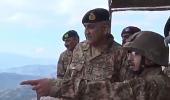Instead of writing NAM's obituary, India should reinvent it, suggests Dr Rup Narayan Das.

Where does the Non-Alignment Movement stand today? Is it dead? Has it lost its relevance and salience? Has the end of the Cold War rendered it obsolete? The answers to such questions is rather complex.
India was one of the few prominent founding members of NAM, which has seemingly lost much of its elan in contemporary times.
How does India look at it today? Well, the answer to this is very much evident in the government's decision to represent the country at the NAM summit at Baku in Azerbaijan on 25th and 26th of this month by Vice-President Shri Venkaiah Naidu.
The vice-president occupies the second position in the warrant of precedent in the pecking order of the Constitutional hierarchy after the President although the prime minister is the head of the government.
As such, it is a nuanced approach to India's participation at the NAM summit.
It suggests that India has not distanced itself from the movement, rather continues to be an active stake holder in NAM's goals, objectives, values and principles which is very much relevant even today.
NAM is certainly not dead; its spirit permeates in India's foreign policy anchored in strategic autonomy and multi-alignment.
Many countries in the world, more particularly the Afro-Asian countries, would like to resurrect it.
True, NAM stood for equidistance, but it is equally true that it stood for equi-proximity.
Historically and chronologically NAM stood for three 'D's -- Decolonisation, Disarmament and Development.
Decolonisation is over; THE need for genuine disarmament is more pressing today than ever before.
The spasm between the rich and the poor -- both within the countries and among the developed and under developed countries -- is growing.
Income inequality is on the rise.
There is growing protectionism including by countries like the USA.
The least developing countries are vulnerable.
Climate change poses a threat to all the countries, more so to small island countries.
These were the issues which the Non-Alignment Movement espoused during its hey day.
Instead of writing NAM's obituary, India should reinvent and resurrect it, and innovate it by value addition such as taking up developmental and social issues.
If it can shed its Cold War trappings and engage with developed economy, India can work like a bridge between the developing world and the developed world.
Who can forget that it is NAM that fought to reform Bretton Woods institutions like the IMF and the World Bank and create a new financial architecture like the New International Economic order?
At a time when India has emerged as the fastest growing economy in the world, in spite of the slowdown of the economy, it is better positioned today to resurrect NAM.
It is worthwhile to refer to a very observation in the report Nonalignment 2.0 published in 2012.
The report said, '...Nonalignment will no longer be limited to avoiding becoming a frontline state in a conflict between two powers. It will instead require a very skilful management of complicated coalitions and opportunities in environments that may be inherently unstable and volatile rather than structurally settled...'
'...Under no circumstances should India jeopardise its own domestic economic growth...' the report further observed.
Taking the assertions further and while criticising the conclusions of Nonalignment 2.0, Ashley J Tellis in Nonalignment Redux argues that 'when economic interdependence coexists with interState competition -- as it does today -- a country must maximise its relative gains through tightened affiliations with a small number of friends and allies.'
This seems to have resonance for India's engagement with Iran in the context of regional geopolitics.
Iran is an important player in the region and India needs to take it on board for any configuration in the interest of regional peace and stability.
As regards the objectives of the document the preface to the report said, it is three fold -- 'to lay out the opportunities that India enjoys in the international sphere; to identify the challenges and threats it is likely to confront and define the broad perspective and approach that India should adopt as it works to enhance its strategic autonomy in global circumstances that for some time to come, are likely to remain volatile and uncertain'.
Although it does not spell out the opportunities, presumably they are India's democratic and soft power profile with its imperfections; India's resilient economy and related to it India's integration to the global economy.
As far as India is concerned it may be mentioned that India has been following a nuanced approach in its relationship with the US and China.
Nonalignment should not be perceived as, what Ashley Tellis dubs as 'the Perils of old Wine in the New Skins'; instead it should be resurrected as an inclusive global order to grapple with the imperfections of an emerging world order.
Dr Rup Narayan Das is currently a senior fellow at the Indian Council of Social Science Research affiliated to the Indian Institute of Public Administration.










